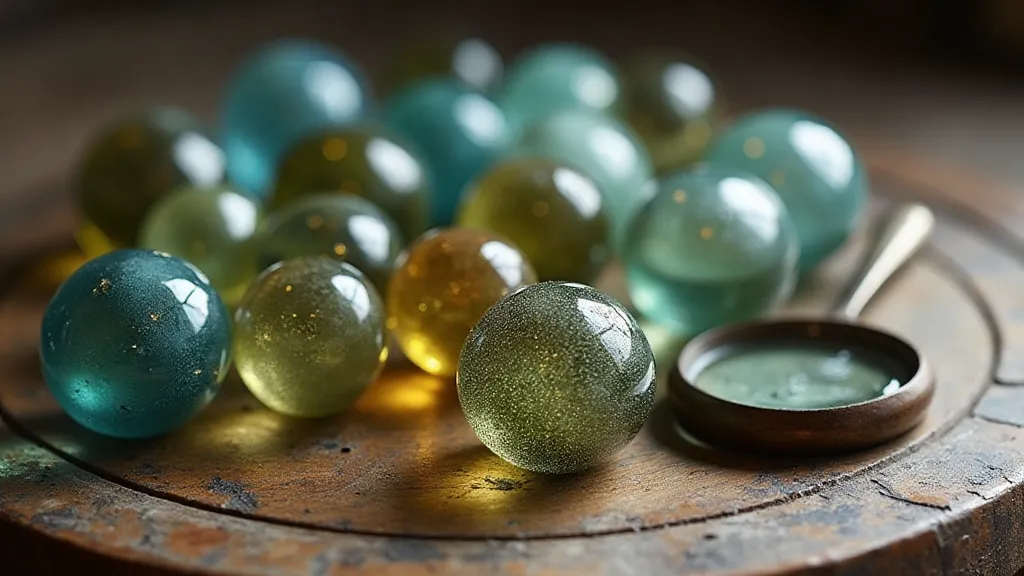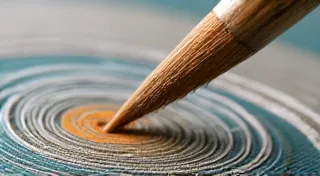The Luminescence of Loss: How Damage Reveals a Marble's Past
We, as marble collectors, often pursue perfection. A pristine swirl, a flawless cat's eye, a vibrant color unbroken by flaw – these are the treasures we covet. But what if I told you that the very marks of time, the chips, the scratches, the subtle imperfections, are often far more valuable than the absence of them? What if the luminescence isn't in the shine, but in the story etched onto the glass?
My own journey into marble collecting began not with the pursuit of flawless beauty, but with a single, profoundly damaged marble. It was a common sulphide, a faded, brown swirl depicting a long-forgotten dog. Half the surface was missing, revealing the underlying glass, and a network of fine scratches marred the remaining design. I almost dismissed it. Then I held it up to the light.
Suddenly, I wasn’t seeing a damaged object; I was holding a fragment of a child's history. I imagined a small hand, clutching this very marble, skipping stones down a dusty lane in a forgotten town. I saw a laughter, a scuffed knee, a moment of simple joy frozen in time. The loss wasn’t a diminishment; it was an expansion – a doorway to the past.

The Echoes of Play
Antique marbles, especially those from the late 1800s and early 1900s, weren’t manufactured in sterile labs. They were crafted by hand, often in small workshops employing both skilled artisans and children. The process was rough and tumble. Glass was melted, shaped, and cooled – often with little concern for cosmetic perfection. Chips and scratches were inevitable, a natural consequence of the manufacturing process and, more importantly, the inevitable roughhousing that occurred during playtime.
Consider the clay marbles, much more fragile than their glass counterparts. These were frequently lost in the dirt, subjected to the elements, and sometimes even used as makeshift projectiles in heated games. A chipped clay marble speaks volumes about the vigor of childhood, the intensity of the games played, and the countless times it was handled and cherished. Think about a child, perhaps too young to fully grasp the value of their possessions, digging furiously in the dirt, hoping to unearth just one more prize to add to their collection. That marble, with its earthy patina and telltale signs of wear, is a tangible link to that moment of focused determination.
The marks we observe aren't blemishes, but rather biographical data. The depth and angle of a scratch can sometimes even suggest the nature of the incident that caused it – a careless drop onto pavement, a collision with another marble, or perhaps even a deliberate attempt to carve a small, hidden mark.
The Language of Glass
Beyond the direct consequences of play, the "damage" on antique marbles can also reveal insights into their manufacturing and composition. Tiny bubbles trapped within the glass – often dismissed as flaws – were actually quite common and are often indicative of the glassmaking techniques of the era. The presence or absence of these bubbles, and their distribution within the marble, can help differentiate between manufacturers and even specific production runs.
“Crazing,” a network of fine, hairline cracks, is another common phenomenon, particularly in marbles made from certain types of glass. This occurs due to internal stresses within the glass, often resulting from uneven cooling or changes in temperature. While it can detract from the visual appeal, it also provides a fascinating glimpse into the material properties of the glass and the manufacturing processes involved. It's a subtle fingerprint of history, visible only with careful observation.

Restoration: A Delicate Balance
The temptation to “restore” a damaged marble is understandable. But as collectors, we have a responsibility to preserve the integrity of these objects, to honor their history. Aggressive polishing can erase valuable clues, obliterating the very evidence that makes the marble unique. A simple cleaning – removing years of accumulated grime – is often the most appropriate intervention.
However, there are situations where gentle restoration can be ethically justified. For example, a loose chip can be carefully stabilized, preventing further deterioration. But even then, the repair should be minimal, visible, and clearly documented. The goal isn’t to make the marble look flawless, but to arrest further decay and preserve the story it holds.
Valuation and the Value of Authenticity
Interestingly, the perceived value of antique marbles doesn't always correlate with their physical perfection. While pristine examples undoubtedly command a premium, marbles with character – those bearing the marks of time – can sometimes be even more desirable to collectors. A well-worn sulphide, a clay marble with a distinctive crack – these can be treasured for their authenticity and the stories they evoke.
The presence of damage can even be a powerful indicator of authenticity. Modern reproductions often lack the subtle imperfections and wear patterns of genuine antique marbles. A "too-perfect" marble is often a red flag, suggesting it's a fake.

Embracing the Imperfect Narrative
As marble collectors, we are not merely accumulating objects; we are custodians of history. We are preserving fragments of childhood memories, echoes of a bygone era. So, the next time you encounter a marble with a chip, a scratch, or a network of crazing, don't see a flaw. See a story. See a journey. See the luminescence of loss – a testament to the enduring power of simple pleasures and the indelible mark they leave on the world.
Let us celebrate the imperfect narrative, the tangible connection to the past, and the quiet beauty of a marble that has truly lived.





